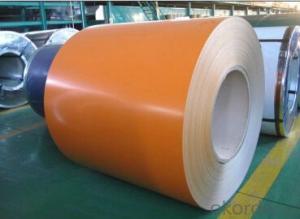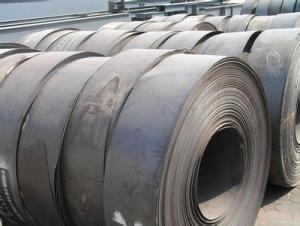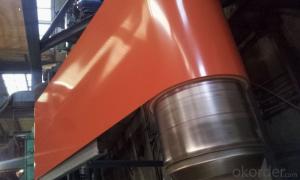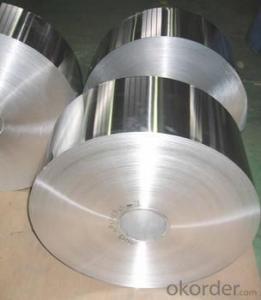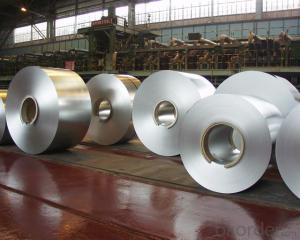PPGI Prepainted Galvanized steel Coil ASTM 615-009
- Loading Port:
- Tianjin
- Payment Terms:
- TT OR LC
- Min Order Qty:
- 22 kg/m²
- Supply Capability:
- 11 kg/m²/month
OKorder Service Pledge
OKorder Financial Service
You Might Also Like
1.Structure of Prepainted Galvanized steel Coil :
With Gi as base metal,after pretreatmet (degrease and chemical treatment) and liquid dope with several Layers of color,then after firing and cooling,finally the plate steel is called pre-painted galvanized steel ( PPGI) .Pre-painted galvanized steel is good capable of decoration ,molding,corrosion resistance lowering the cost of production and increasing the quality of the metal. Today, steel is one of the most common materials in the world, with more than 1.3 billion tons produced annually. It is a major component in buildings, infrastructure, tools, ships, automobiles, machines, appliances, and weapons. Modern steel is generally identified by various grades defined by assorted standards organizations.
2.Main Features of Prepainted Galvanized steel Coil:
• Excellent process capability
• Smooth and flat surface
• Workability, durability
• Excellent heat resistance performance
• High strength
• Good formability
• Good visual effect
3.Prepainted Galvanized steel Coil Images

4.Prepainted Galvanized steel Coil Specification
Community portal – Bulletin board, projects, resources and activities covering a wide range of Wikipedia areas.
Help desk – Ask questions about using Wikipedia.
Local embassy – For Wikipedia-related communication in languages other than English.
Reference desk – Serving as virtual librarians, Wikipedia volunteers tackle your questions on a wide range of subjects.
Site news – Announcements, updates, articles and press releases on Wikipedia and the Wikimedia Foundation.
Village pump – For discussions about Wikipedia itself, including areas for technical issues and policies.
C | Si | Mn | Cr | Ni | P | S |
0.150 | 0.476 | 11.231 | 12.50 | 0.900 | 0.039 | 0.010
|
5.FAQ of Prepainted Galvanized steel Coi
We have organized several common questions for our clients,may help you sincerely:
1.How do you control your quality
We have established the international advanced quality management system,every link from raw material to final product we have strict quality test;We resolutely put an end to unqualified products flowing into the market. At the same time, we will provide necessary follow-up service assurance.
2.how long we will receive the goods ?
After receiving your deposit or workable lc ,our normal shipment date is 15-20days,and it takes around 28 days to reach your port of destination. But is up to different destination The bar-throated minla (Minla strigula) is a species of bird found in the montane forests of the Indian subcontinent and Southeast Asia.
3. what is your moq
Normally our moq is 25per size ,but it is up to different size
- Q:How are steel strips used in the production of agricultural equipment?
- Steel strips are used in the production of agricultural equipment for various purposes such as reinforcement, structural support, and forming various components like blades, brackets, and frames. The steel strips provide strength, durability, and stability to the equipment, ensuring their ability to withstand harsh conditions and heavy loads encountered during agricultural operations.
- Q:What are the factors that affect the vibration damping properties of steel strips?
- The vibration damping properties of steel strips can be influenced by various factors. 1) The material composition, including the type and amount of alloying elements, can play a role in the ability of the steel strip to dampen vibrations. For instance, adding elements like manganese or silicon can enhance the damping properties of steel. 2) The microstructure of the steel strip, which is determined by factors such as the cooling rate during manufacturing, can affect its damping properties. Fine-grained structures are generally known to exhibit better damping characteristics compared to coarse-grained structures. 3) The thickness and width of the steel strip can also impact its damping properties. Thicker and wider strips tend to have better damping properties as they offer a larger surface area for energy dissipation. On the other hand, thinner and narrower strips may exhibit higher vibration amplitudes and reduced damping. 4) The surface finish of the steel strip, including factors like roughness and imperfections, can influence its ability to dampen vibrations. Smoother surfaces with lower roughness values tend to provide better damping characteristics. 5) The temperature at which the steel strip operates can affect its damping properties. Generally, higher temperatures can reduce the damping capacity of steel as thermal energy can interfere with the dissipation of vibrational energy. 6) The damping properties of the steel strip can also be influenced by the magnitude and type of load applied to it. Factors such as the frequency, amplitude, duration, and cyclic nature of the applied load can impact vibration damping. 7) Environmental conditions, such as the presence of moisture or corrosive substances, can affect the damping properties of steel strips. If the material corrodes or degrades, it can lead to a decrease in damping performance. 8) The manufacturing process used to produce the steel strip, whether it is hot rolling or cold rolling, can affect its damping properties. Different manufacturing processes can result in variations in microstructure and material properties, which in turn can impact the ability to dampen vibrations. In summary, the vibration damping properties of steel strips are determined by a combination of these factors. Understanding their influence is crucial for designing and selecting materials with optimal damping characteristics for specific applications.
- Q:Can steel strips be used in the production of kitchen appliances?
- Yes, steel strips can be used in the production of kitchen appliances. Steel is a common material used in the manufacturing of kitchen appliances due to its durability, strength, and resistance to heat and corrosion. Steel strips can be formed into various components and parts such as panels, frames, and shelves, making them suitable for use in kitchen appliances like ovens, refrigerators, and dishwashers.
- Q:Can steel strips be used for making tools or machinery parts?
- Yes, steel strips can be used for making tools or machinery parts. Steel strips are versatile and commonly used in various industries for their strength, durability, and ease of fabrication. They can be cut, shaped, and formed into specific tool or machinery parts, providing the necessary strength and reliability required for these applications.
- Q:What are the applications of steel strips?
- Steel strips have a wide range of applications across various industries. They are commonly used in automotive manufacturing for making components such as brackets, reinforcements, and spring clips. Steel strips are also utilized in construction for manufacturing structural elements like beams, columns, and joists. Additionally, they find applications in the production of furniture, appliances, electrical enclosures, and packaging materials due to their durability and formability.
- Q:What are the different methods for welding steel strips?
- Welding steel strips can be accomplished through various methods, each with its own benefits and applications. Some commonly employed techniques are: 1. Arc Welding: This method employs an electric arc to generate heat and melt the steel strips. Different types of arc welding, like Shielded Metal Arc Welding (SMAW), Gas Metal Arc Welding (GMAW), and Flux-Cored Arc Welding (FCAW), offer versatility and suitability for different strip thicknesses. 2. TIG Welding: Tungsten Inert Gas (TIG) welding is widely used for steel strip welding. It employs a non-consumable tungsten electrode to create an arc, and filler material is added if necessary. TIG welding delivers high-quality and precise welds, making it ideal for delicate strips and critical applications. 3. MIG Welding: Metal Inert Gas (MIG) welding is a semi-automatic technique that utilizes a consumable wire electrode and inert gas to shield the weld pool. It is a fast and efficient process, well-suited for industrial applications involving steel strip welding. 4. Laser Welding: This non-contact method employs a powerful laser beam to melt and join the steel strips. Laser welding offers precise control and minimal heat input, resulting in narrow and clean welds. It is commonly used in industries like electronics and automotive for thin steel strips. 5. Resistance Welding: Resistance welding utilizes the heat generated from an electric current passing through the steel strips to join them. Spot welding, seam welding, and projection welding are different types of resistance welding. The automotive industry frequently employs this method to join steel strips together. 6. Plasma Arc Welding: Plasma arc welding is a variation of TIG welding that employs a focused plasma arc to melt the steel strips. It provides higher energy density compared to conventional TIG welding, enabling faster welding speeds and deeper penetration. Plasma arc welding finds applications in industries such as aerospace and shipbuilding, particularly for thicker steel strips. Overall, the selection of a welding method for steel strips depends on factors like strip thickness, desired weld quality, and specific application requirements. Each method offers unique advantages and should be chosen based on the project's specific needs.
- Q:What are the factors that affect the impact resistance of steel strips?
- There are several factors that can significantly influence the impact resistance of steel strips. 1. Composition: The chemical composition of the steel strip plays a crucial role in determining its impact resistance. The presence of certain alloying elements, such as manganese, nickel, and chromium, can enhance the steel's ability to withstand impact forces. 2. Hardness: The hardness of the steel strip is another key factor. Hardened steel strips tend to have higher impact resistance due to their ability to absorb energy and resist deformation under impact. 3. Microstructure: The microstructure of the steel strip, including factors such as grain size and distribution, can greatly influence its impact resistance. A fine and uniform microstructure tends to enhance the steel's toughness and resistance to crack propagation. 4. Heat treatment: Heat treatment processes, such as quenching and tempering, can significantly affect the impact resistance of steel strips. Proper heat treatment can improve the steel's strength and toughness, making it more resistant to impact. 5. Surface condition: The surface condition of the steel strip, including factors like surface roughness and defects, can affect its impact resistance. Smooth and defect-free surfaces tend to provide better resistance against impact forces. 6. Thickness: The thickness of the steel strip also plays a role in its impact resistance. Thicker strips generally offer better resistance to impact, as they can absorb and distribute the energy more effectively. 7. Temperature: The temperature at which the steel strip operates can impact its impact resistance. Steel strips exposed to low temperatures may become more brittle, reducing their ability to withstand impact forces. 8. Manufacturing process: The method used to manufacture the steel strip can influence its impact resistance. Factors such as rolling, heat treatment, and cooling methods can all affect the final properties of the strip, including its impact resistance. Overall, a combination of these factors determines the impact resistance of steel strips. Manufacturers must carefully consider these factors to ensure that the steel strips meet the desired impact resistance requirements for specific applications.
- Q:How do steel strips contribute to reducing downtime in various applications?
- There are several ways in which steel strips help to reduce downtime in various applications. To begin with, steel strips are renowned for their strength and durability. This means they can withstand heavy loads, high temperatures, and harsh environments without easily deforming or breaking. This strength and durability ensure that the equipment or machinery in which steel strips are used can operate continuously without frequent breakdowns. Consequently, there is less need for downtime to repair or replace damaged components. Moreover, steel strips are commonly used in applications where precision and accuracy are paramount. For instance, in the automotive industry, steel strips are employed in manufacturing various components, such as suspension parts, body panels, and engine components. These components must be manufactured to exact specifications to guarantee smooth operation and optimal performance. The dimensional stability and precision of steel strips help to minimize downtime caused by misalignment, poor fit, or malfunctioning parts. Additionally, steel strips exhibit high corrosion-resistance. They are frequently utilized in applications that are exposed to moisture, chemicals, or other corrosive elements. By employing steel strips that are resistant to corrosion, the risk of rust, degradation, or failure due to corrosive factors is minimized. This diminishes the frequency of maintenance, repairs, or replacements, thereby reducing downtime in the long run. Furthermore, steel strips can be easily formed, shaped, or welded to meet specific design requirements. This flexibility allows manufacturers to create intricate components or structures tailored to their specific application needs. By utilizing steel strips that can be easily customized, manufacturers can reduce the time required for production, assembly, and installation. Ultimately, this contributes to reducing downtime as the equipment or machinery can be brought into operation more quickly. In conclusion, steel strips contribute to reducing downtime in various applications by providing strength and durability, ensuring precision and accuracy, offering corrosion resistance, and enabling easy customization. These qualities of steel strips help minimize breakdowns, malfunctions, and maintenance requirements, ultimately leading to increased uptime and improved productivity in various industries.
- Q:Can steel strips be used for making electrical enclosures?
- Yes, steel strips can be used for making electrical enclosures. Steel is a durable and strong material that provides excellent protection for electrical components and can withstand various environmental conditions. Additionally, steel strips can easily be formed and welded to create custom-sized enclosures, making them a popular choice in the electrical industry.
- Q:Can steel strips be used in marine or offshore applications?
- Marine or offshore applications can benefit from the utilization of steel strips. Steel, being a versatile and durable material, can endure harsh environmental conditions, including exposure to saltwater and high levels of humidity. Various marine and offshore projects, such as shipbuilding, offshore platforms, pipelines, and underwater structures, can make use of steel strips. To ensure resistance to corrosion, steel strips employed in marine or offshore applications are typically crafted from corrosion-resistant alloys or coated with protective coatings. These coatings, which may consist of galvanization, epoxy coatings, or specialized marine-grade paint systems, serve to prevent rust and corrosion. By employing these protective measures, the longevity of steel strips in marine environments is extended as they can withstand the corrosive effects of saltwater. The high strength-to-weight ratio possessed by steel strips makes them a popular choice in marine and offshore applications. This characteristic is essential in constructing structures that are lightweight yet robust. Furthermore, steel is easily workable and can be fabricated into various shapes and sizes, rendering it suitable for a wide range of marine and offshore projects. In conclusion, steel strips are an economical and dependable option for marine and offshore applications. They provide durability, resistance to corrosion, and structural integrity in demanding environments.
1. Manufacturer Overview |
|
|---|---|
| Location | |
| Year Established | |
| Annual Output Value | |
| Main Markets | |
| Company Certifications | |
2. Manufacturer Certificates |
|
|---|---|
| a) Certification Name | |
| Range | |
| Reference | |
| Validity Period | |
3. Manufacturer Capability |
|
|---|---|
| a)Trade Capacity | |
| Nearest Port | |
| Export Percentage | |
| No.of Employees in Trade Department | |
| Language Spoken: | |
| b)Factory Information | |
| Factory Size: | |
| No. of Production Lines | |
| Contract Manufacturing | |
| Product Price Range | |
Send your message to us
PPGI Prepainted Galvanized steel Coil ASTM 615-009
- Loading Port:
- Tianjin
- Payment Terms:
- TT OR LC
- Min Order Qty:
- 22 kg/m²
- Supply Capability:
- 11 kg/m²/month
OKorder Service Pledge
OKorder Financial Service
Similar products
New products
Hot products
Related keywords
